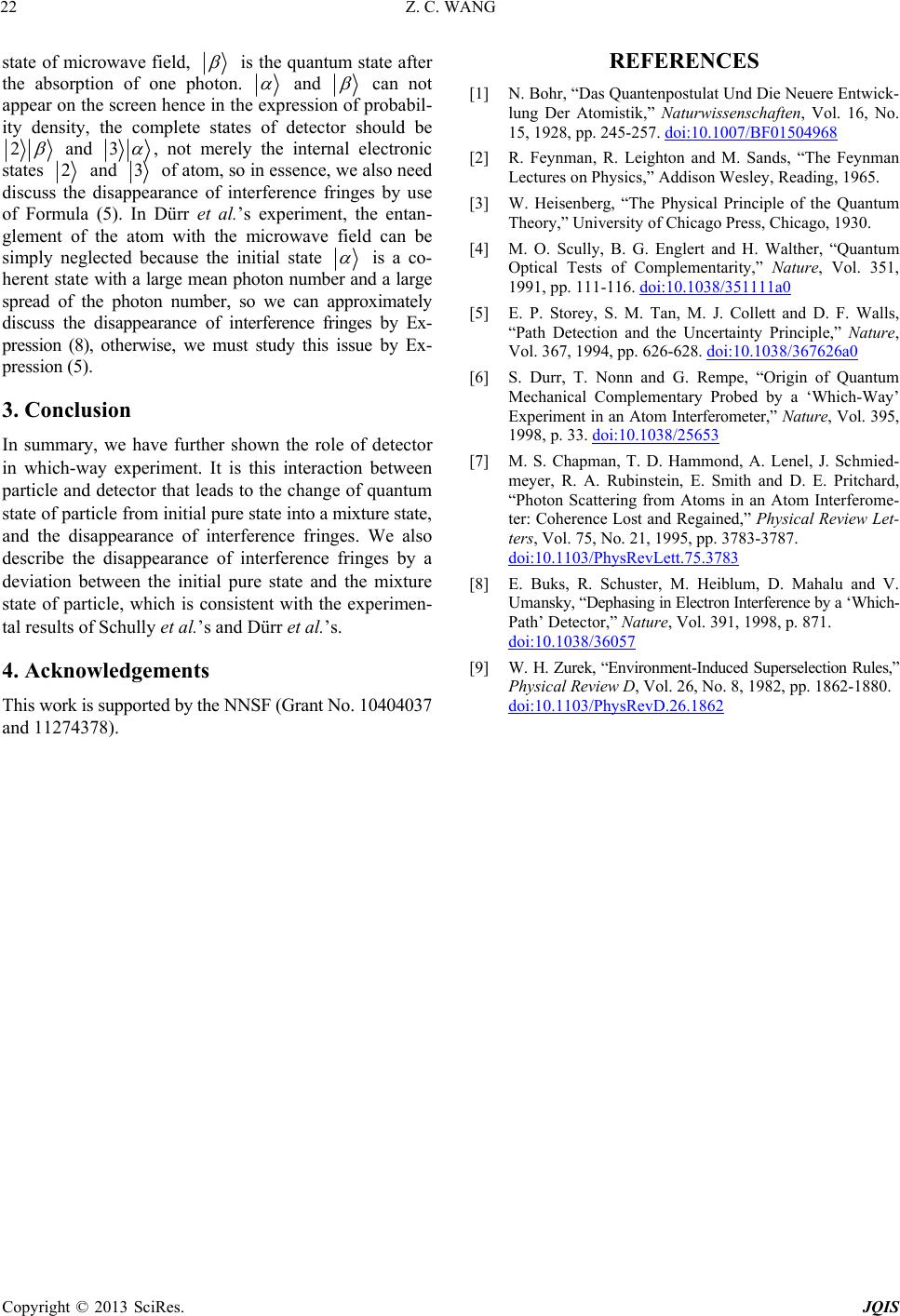
Z. C. WANG
Copyright © 2013 SciRes. JQIS
22
REFERENCES
state of microwave field,
is the quantum state after
the absorption of one photon.
and
can not
appear on the screen hence in the expression of probabil-
ity density, the complete states of detector should be
2
and 3
, not merely the internal electronic
states 2 and 3 of atom, so in essence, we also need
discuss the disappearance of interference fringes by use
of Formula (5). In Dürr et al.’s experiment, the entan-
glement of the atom with the microwave field can be
simply neglected because the initial state
is a co-
he rent state with a large mean photon number and a large
spread of the photon number, so we can approximately
discuss the disappearance of interference fringes by Ex-
pression (8), otherwise, we must study this issue by Ex-
pression (5).
[1] N. Bohr, “Das Quantenpostulat Und Die Neuere Entwick-
lung Der Atomistik,” Naturwissenschaften, Vol. 16, No.
15, 1928, pp. 245-257. doi:10.1007/BF01504968
[2] R. Feynman, R. Leighton and M. Sands, “The Feynman
Lectures on Physics,” Addison Wesley, Reading, 1965.
[3] W. Heisenberg, “The Physical Principle of the Quantum
Theory,” University of Chicago Press, Chicago, 1930.
[4] M. O. Scully, B. G. Englert and H. Walther, “Quantum
Optical Tests of Complementarity,” Nature, Vol. 351,
1991, pp. 111-116. doi:10.1038/351111a0
[5] E. P. Storey, S. M. Tan, M. J. Collett and D. F. Walls,
“Path Detection and the Uncertainty Principle,” Nature,
Vol. 367, 1994, pp. 626-628. doi:10.1038/367626a0
[6] S. Durr, T. Nonn and G. Rempe, “Origin of Quantum
Mechanical Complementary Probed by a ‘Which-Way’
Exp eriment in an Atom Interferometer,” Nature, Vol. 395,
1998, p. 33. doi:10.1038/25653
3. Conclusion
In summary, we have further shown the role of detector
in which-way experiment. It is this interaction between
particle and detector that leads to the change of quantum
state of particle from initial pure state into a mixture state,
and the disappearance of interference fringes. We also
describe the disappearance of interference fringes by a
deviation between the initial pure state and the mixture
state of particle, which is consistent with the experimen-
tal results of Schully et al.’s and Dürr et al.’s.
[7] M. S. Chapman, T. D. Hammond, A. Lenel, J. Schmied-
meyer, R. A. Rubinstein, E. Smith and D. E. Pritchard,
“Photon Scattering from Atoms in an Atom Interferome-
ter: C oherence Lost and Regained ,” Physical Review Let-
ters, Vol. 75, No. 21, 1995, pp. 3783-3787.
doi:10.1103/PhysRevLett.75.3783
[8] E. Buks, R. Schuster, M. Heiblum, D. Mahalu and V.
Um ansky, “Dephasing in Electron Interference by a ‘Which-
Path’ Detector,” Nature, Vol. 391, 1998, p. 871.
doi:10.1038/36057
4. Acknowledgements [9] W. H. Zurek, “Environment-Induced Superselection Rules,”
Physical Review D, Vol. 26, No. 8, 1982, pp. 1862-1880.
doi:10.1103/PhysRevD.26.1862
This work is supported by the NNSF (Grant No. 10404037
and 11274378).